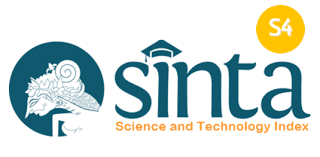EFFECTIVENESS OF BASIL LEAF (OCIUM BASILICUM L.) NANOHERBAL AS ANTIHYPERGLYCEMIAIN STREPTOZOTOCIN – INDUCED DIABETIC RAT
Abstract
Diabetes merupakan penyakit kronis yang terjadi di saat insulin yang diproduksi oleh tubuh tidak bisa digunakan secara efektif maupun organ pankreas mengalami masalah dimana insulin tidak dapat diproduksi sebagaimana mestinya. Diabetes Mellitus dibagi menjadi dua jenis yaitu IDDM (DM tipe I) dan NIDDM (DM tipe 2. Kebaruan penelitian ini menguji efektivitas nonherbal kemangi sebagai antihiperglikemia pada tikus diabetes yang terindukasi streptozotocin. Penelitian ini bertujuan untuk menganalisis dan meninjau hewan dan penelitian pada tikus putih yang diinduksi STZ. Pencarian elektronik dilakukan dengan mencari MEDLINE melalui platform PubMed, Web of Science, Embase melalui platform Ovid, CINAHL, dan Scopus. Penulis juga akan mencari literatur kelabu seperti makalah konferensi, laporan teknis, tesis, dan disertasi di Google Scholar, Google, OpenGrey, ProQuest Disertasi & Tesis, dan British Library Ethos. Penulis mencari database sebanyak 5655 artikel dari November 2011 hingga November 2021 menggunakan kata kunci MeSH. Istilah pencarian dibagi menjadi tiga komponen, yaitu komponen populasi yang meliputi kata-kata “hewanâ€, “model hewanâ€, “studi praklinisâ€, “hewan percobaanâ€, “hewan percobaanâ€, “hewan laboratorium, †"tikus", "kelinci", "tikus diabetes", "model penyakit hewan". Komponen intervensi dengan kata-kata “Ocium Basilicum†“kemangi,†dan “nano herbal,†Akhirnya, istilah komponen penyakit akan menjadi "diabetes mellitus, tipe 2," "diabetes mellitus tidak tergantung insulin," "NIDDM," "gangguan metabolisme glukosa," "penyakit metabolik," "hiperlipidemia," "hiperglikemia," "insulin resistensi," dan "intoleransi glukosa." Hasilnya menunjukkan bahwa Efektifitas Nanoherbal kemangi (Ocium Basilicum) sebagai Antihiperglikemia pada tikus diabetes yang terinduksi Streptozotocin. Kesimpulannya Selain efek antioksidan, Nanoherbal kemangi menunjukkan efek antidiabetes yang efektif dalam menurunkan gula darah tinggi.
Katakunci: Diabetes; Streptozotocin; Kemangi.
Abstrack
Diabetes is a chronic disease that occurs when the insulin produced by the body cannot be used effectively or the pancreas has problems where insulin cannot be produced properly. Diabetes Mellitus is divided into two types namely IDDM (type I DM) and NIDDM (type 2 diabetes). The novelty of this study tested the effectiveness of non-herbal basil as an antihyperglycemic agent in streptozotocin-induced diabetic rats. of Science, Embase via Ovid, CINAHL, and Scopus platforms. Authors will also search gray literature such as conference papers, technical reports, theses, and dissertations on Google Scholar, Google, OpenGrey, ProQuest Dissertations & Theses, and British Library Ethos. Authors search a database of 5655 articles from November 2011 to November 2021 using the keyword MeSH. The search term is divided into three components, namely the population component which includes the words “animalâ€, “animal modelâ€, “preclinical studyâ€, “experimental animalâ€, “ experimental animalâ€, “laboratory animal,†“ratâ€, “rabbitâ€, “diabetic ratâ€, “animal disease modelâ€. Components of the intervention with the words “OciumBasilicum†“k emangi,†and “herbal nano,†Eventually, the disease component terms would become “diabetes mellitus, type 2,†“noninsulin dependent diabetes mellitus,†“NIDDM,†“glucose metabolism disorder,†“metabolic disease,†“hyperlipidemia, " "hyperglycemia," "insulin resistance," and "glucose intolerance." The results show that the effectiveness of basil nanoherbal (OciumBasilicum) as antihyperglycemia in Streptozotocin-induced diabetic rats. Conclusion : In addition to the antioxidant effect, the basil nanoherbal showed an effective antidiabetic effect in lowering high blood sugar.
Keywords: Diabetes; Streptozotocin; Basil.
Keywords
Full Text:
PDFReferences
Sivakumar S. SS. Pancreatic tissue protective nature of D-Pinitol studied in streptozotocin mediated oxidative in experimental diadetic rats. Uur.J of Pharmacol, 622:56-70. 2009.
Sheikhpour R. Diabetes and oxidative stree : The machanism and action. Iran J diabetes Obes 5(1). 2013.
Vasconcelos CFB, Maranhao HML, Batista TM, Carneiro EM, Ferreira F CJ, Soares, LAL, Sa MDC, Souza TP WA. Hypoglycaemic activity and molecular mechanisms of Caesalpiniaferrea Martius bark extract on streptozotocin- induced diabetes in Wistar rats. Journal of Ethnopharmacology 137: 1533-1541. 2011.
Soegondo S. Diagnosis dan Klasifikasi Diabetes Mellitus Terkini, Dalam: Subekti, Imam, et al. Penatalaksanaan Diabetes Mellitus Terpadu. Jakarta : FKUI.2005. 2005.
Wild S, Roclic G, Green A, Sicree R KH. Global prevalence in diabetes: estimates for the year 2000 and projection for 2030. J Life Sci. 2004;2(5):1047-53. 2004.
World Health Organization. Diabetes. Fact Sheet no. 312. Geneva, 2015. (serialonline),URL:http://www.who.int/medicentre/factsheets/fs312/en/Toni,. 2005.
Suyono. Kecenderungan Peningkatan Pasien Diabetes Mellitus. Penatalaksanaan Diabetes Terpadu. FKUI: Jakarta. 2010.
AHA ( American Heart Association ). Heart Disease and Stroke Statistics Update. 2012.
Kementerian Kesehatan Republik Indonesia. Tahun 2030 Prevalensi Diabetes Mellitus Di Indonesia Mencapai 21,3 juta orang. 2012. http://www.depkes.go.id2012.html. 2012.
Maulana M. Mengenal Diabetes Melitus : Panduan Praktis Menangani Kencing Manis. Jogjakarta: Katahati. 2008.
Halliwel B and JM. Gutterridge. Free radicals, reactive species and toxicology. Dalam: Free radicals in Biology and medicine Third edition. New York: Oxford University Press:547-550. 2005.
Ueno Y, Kizaki M, Nakagiri R, Kamiya T, Sumi H O. Dietary Gluthatione Protects Rats From Diabetic Nephropathy and Nueropathy. J Nutr. 2002;132:897-900. 2002.
Age S. Pengaruh Pemberian Rebusan Daun Kelor Terhadap Penurunan Kadar Glukosa Darah Diabetes Melitus. J Heal Sci ; Gorontalo J Heal Sci Community. 2021;5(no.2):252-7.
Dinia RD, M. Sasmito D MI and MR. The Potential of VipAlbumin to Chronic Inflamation in Type 2 Diabetes Mellitus Balb/C Mice Model. American Journal of Immunology. 2015.
Patel, S.S., Shah, R.S. and Goyal RK. Antihyperglicemic Antihyperlipidemic and Antioxidant Effects of Dihar, a Polyherbal Ayurdevic Formulation in Streptozotocin Induced Diabetics rats. Indian Journal of Experimental Biology. 47:564-570.
Weyer C, Bogardus C, Mott DM PR. The natural history of insulin secretory dysfunction and insulin resistance in the pathogenesis of type 2 diabetes mellitus. J Clin Invest. 1999;104(6):787-94. 1999.
Singh MP PK. Animal models for biological screening of anti-diabetic drugs: an overview. Eur J Exp Biol. 2015;5(5):37-48. 2015.
Karthikeyan M, Balasubramanian T KP. In-vivo animal models and in-vitro techniques for screening antidiabetic activity. J Dev Drugs. 2016;5(2):1-6. 2016.
King AJF. The use of animal models in diabetes research. Vol. 166, British Journal of Pharmacology. 2012. p. 877-94. 2012.
De Vries RBM, Hooijmans CR, Tillema A, Leenaars M R-HM. A search filter for increasing the retrieval of animal studies in Embase. Lab Anim. 2011;45(4):268-70. 2011.
Valentine JC, Pigott TD RH. How many studies do you need? A primer on statistical power for meta-analysis. J Educ Behav Stat. ;35(2):215-47. 2010.
DOI: https://doi.org/10.35971/jjhsr.v4i3.13460
Refbacks

This work is licensed under a Creative Commons Attribution-ShareAlike 4.0 International License.
Jambura Journal of Health Sciences and Research is licensed under a Creative Commons Attribution-ShareAlike 4.0 International License
</p



_.png)




_edit.png)




